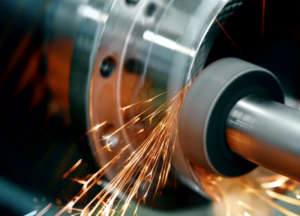Sheet metal is a versatile and widely used material in various industries, from automotive and aerospace to construction and manufacturing. Its popularity stems from its exceptional strength-to-weight ratio and ease of fabrication. However, raw sheet metal is susceptible to corrosion, wear, and aesthetic degradation over time. To enhance its durability and performance, sheet metal finishing and coating options play a pivotal role. In this blog, we will delve into the world of sheet metal finishing and coating, exploring the various techniques and materials that can be employed to protect and enhance the longevity of sheet metal components.
What is the Importance of Sheet Metal Finishing and Coating?
Sheet metal components are often subjected to harsh environments, temperature fluctuations, chemicals, and physical wear and tear. Without proper finishing and coating, these factors can lead to several problems, including:

- Corrosion: Sheet metal is particularly vulnerable to corrosion, especially in outdoor or humid environments. Corrosion can weaken the metal, compromise its structural integrity, and reduce its lifespan.
- Aesthetic Degradation: In applications where appearance matters, such as automotive and architectural uses, surface imperfections, scratches, and discoloration can diminish the overall look and value of the product.
- Wear and Tear: Moving parts or components that endure friction can suffer from premature wear and tear, affecting their functionality and efficiency.
- Chemical Resistance: In industries where sheet metal comes into contact with chemicals, it’s essential to protect the metal from chemical reactions that could compromise its properties.
Sheet metal finishing and coating address these issues, providing a protective barrier that extends the life of the components and ensures they perform their intended functions reliably.
What are Sheet Metal Finishing Techniques?
Sheet metal finishing involves preparing the surface of the metal before applying a coating. The choice of finishing technique depends on the specific requirements of the application and the desired surface finish. Here are some common sheet metal finishing techniques:

1. Cleaning and Degreasing: Before any finishing can occur, it’s crucial to remove contaminants like dirt, grease, and rust from the surface of the sheet metal. This can be achieved through processes like solvent cleaning, alkaline cleaning, or abrasive cleaning.
2. Surface Preparation: To ensure proper adhesion of coatings, the sheet metal surface may need to be roughened or etched. Techniques like sandblasting, shot blasting, or chemical etching can be used to achieve the desired surface texture.
3. Deburring: Sheet metal often has sharp edges and burrs resulting from the cutting and forming processes. Deburring involves removing these imperfections to enhance safety and appearance.
4. Polishing and Grinding: For applications where a smooth and reflective surface is required, polishing and grinding are employed. This can be done using abrasive materials and specialized equipment.
5. Anodizing: Anodizing is a popular finishing technique for aluminum sheet metal. It involves creating an oxide layer on the surface of the metal, which not only provides corrosion resistance but also allows for color customization.
What are Sheet Metal Coating Options?
Coating is the final step in enhancing the durability of sheet metal components. Various coating materials and methods can be used, each offering unique benefits. The choice of coating depends on factors like the environment, desired aesthetics, and performance requirements. Here are some common sheet metal coating options:

1. Paints and Primers: Painting sheet metal is a versatile option for both protection and aesthetics. Primers can improve adhesion, while paints can provide corrosion resistance and a wide range of colors and finishes. For outdoor applications, weather-resistant paints are essential.
2. Powder Coating: Powder coating involves applying a dry powder to the sheet metal surface, which is then cured with heat. It creates a durable and uniform finish that is highly resistant to chipping, cracking, and corrosion. Powder coating is commonly used in industries like automotive and architectural design.
3. Galvanizing: Galvanizing is a process where sheet metal is coated with a layer of zinc to protect it from corrosion. It is often used in outdoor and marine applications. Hot-dip galvanizing and electro-galvanizing are two common methods.
4. Electroplating: Electroplating involves depositing a layer of metal, such as chrome or nickel, onto the sheet metal surface. This not only provides corrosion resistance but also enhances the appearance of the component. It is frequently used in the automotive industry for decorative trim.
5. Ceramic Coatings: Ceramic coatings offer exceptional heat resistance and are often used in applications where sheet metal is exposed to high temperatures, such as exhaust systems and industrial equipment.
6. E-coating: E-coating, or electrodeposition coating, involves submerging the sheet metal component in a paint bath and applying an electrical charge to ensure uniform coverage. It is known for its corrosion resistance and is commonly used in the automotive industry.
Factors to Consider When Choosing Finishing and Coating
Selecting the right finishing and coating options for sheet metal is a critical decision that depends on several factors:

1. Environmental Conditions: Consider the environment in which the sheet metal component will be used. Will it be exposed to harsh weather, chemicals, saltwater, or extreme temperatures? This information will guide your choice of coating material.
2. Aesthetic Requirements: For applications where appearance is important, such as consumer products or architectural elements, the choice of finishing and coating can significantly impact the final look and feel of the product.
3. Budget Constraints: Different finishing and coating options vary in cost. It’s essential to balance the desired level of protection with the available budget.
4. Performance Specifications: Sheet metal components often have specific performance requirements, such as wear resistance, electrical conductivity, or thermal resistance. Ensure that the chosen finishing and coating options meet these specifications.
5. Regulatory Compliance: Some industries have strict regulations regarding the use of certain coating materials, especially in applications that come into contact with food, water, or the human body. Ensure compliance with relevant standards and regulations.
Conclusion
Sheet metal is a remarkable material known for its strength and versatility. However, to ensure its longevity and performance in various applications, it often requires proper finishing and coating. The choice of finishing and coating methods and materials should be driven by the specific needs of the project, considering factors such as environmental conditions, aesthetic requirements, and performance specifications. By investing in high-quality finishing and coating, manufacturers can enhance the durability of sheet metal components, reduce maintenance costs, and ensure that their products withstand the test of time. Whether it’s protecting a car’s chassis from rust or adding an elegant finish to architectural elements, sheet metal finishing and coating options play a pivotal role in enhancing the durability and functionality of sheet metal components.


Pingback: What is the Importance of Sheet Metal Finishing and Coating? – Laser Cutting Services